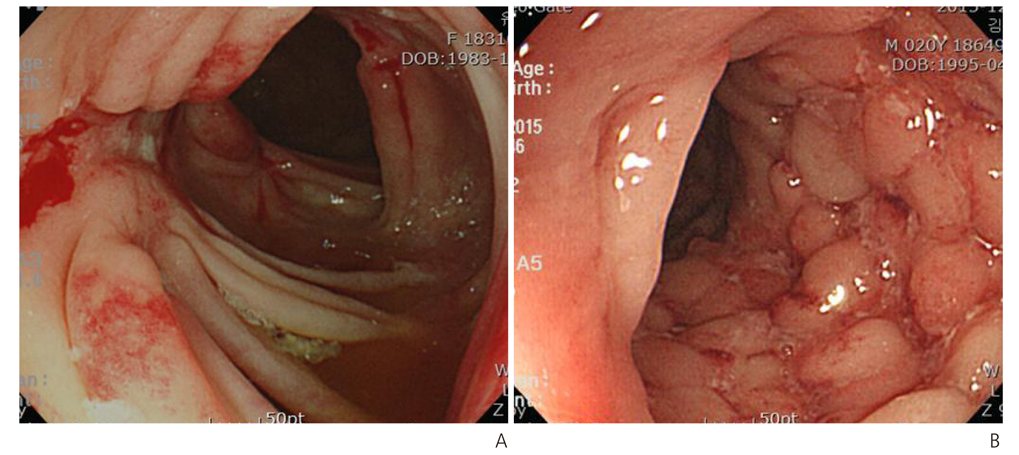J Korean Med Assoc.
2017 Jun;60(6):484-490. 10.5124/jkma.2017.60.6.484.
Diagnosis and treatment of Crohn's disease
- Affiliations
-
- 1Department of Internal Medicine, Chonnam National University Medical School, Gwangju, Korea. dshskim@jnu.ac.kr
- KMID: 2384394
- DOI: http://doi.org/10.5124/jkma.2017.60.6.484
Abstract
- Crohn's disease is a chronic and relapsing disease that is not easily controlled with medications. It is characterized by progressive transmural inflammation, and ultimately leads to stricture and penetrating complications requiring surgery. Over the past decades, the prevalence of Crohn's disease has gradually increased in Korea. Conventional treatments with aminosalicylates, steroids, and immunosuppressants are inadequate to control its symptoms and complications. Biologic therapy shows promise for controlling disease activity and promoting mucosal healing. Despite the development of several medical therapies, the treatment of Crohn's disease remains challenging. Individually tailored treatment according to an endoscopic or symptomatic assessment is required.
Keyword
MeSH Terms
Figure
Reference
-
1. Yang SK, Yun S, Kim JH, Park JY, Kim HY, Kim YH, Chang DK, Kim JS, Song IS, Park JB, Park ER, Kim KJ, Moon G, Yang SH. Epidemiology of inflammatory bowel disease in the Songpa-Kangdong district, Seoul, Korea, 1986-2005: a KASID study. Inflamm Bowel Dis. 2008; 14:542–549.
Article2. Korean Association for the Study of Intestinal Disease. Inflammtory bowel disease. Seoul: Daehan Medical Books;2016.3. Qin G, Tu J, Liu L, Luo L, Wu J, Tao L, Zhang C, Geng X, Chen X, Ai X, Shen B, Pan W. Serum albumin and C-reactive protein/albumin ratio are useful biomarkers of Crohn's disease activity. Med Sci Monit. 2016; 22:4393–4400.
Article4. Yang DH, Yang SK, Park SH, Lee HS, Boo SJ, Park JH, Na SY, Jung KW, Kim KJ, Ye BD, Byeon JS, Myung SJ. Usefulness of C-reactive protein as a disease activity marker in Crohn's disease according to the location of disease. Gut Liver. 2015; 9:80–86.
Article5. Ooi CJ, Makharia GK, Hilmi I, Gibson PR, Fock KM, Ahuja V, Ling KL, Lim WC, Thia KT, Wei SC, Leung WK, Koh PK, Gearry RB, Goh KL, Ouyang Q, Sollano J, Manatsathit S, de Silva HJ, Rerknimitr R, Pisespongsa P, Abu Hassan MR, Sung J, Hibi T, Boey CC, Moran N, Leong RW. Asia Pacific Association of Gastroenterology (APAGE) Working Group on Inflammatory Bowel Disease. Asia-Pacific consensus statements on Crohn's disease. Part 2: management. J Gastroenterol Hepatol. 2016; 31:56–68.
Article6. Yang SK, Min YI. Colonoscopic diagnosis. Seoul: Koonja Publishing;1999.7. Zakeri N, Pollok RC. Diagnostic imaging and radiation exposure in inflammatory bowel disease. World J Gastroenterol. 2016; 22:2165–2178.
Article8. Gasche C, Scholmerich J, Brynskov J, D'Haens G, Hanauer SB, Irvine EJ, Jewell DP, Rachmilewitz D, Sachar DB, Sandborn WJ, Sutherland LR. A simple classification of Crohn's disease: report of the Working Party for the World Congresses of Gastroenterology, Vienna 1998. Inflamm Bowel Dis. 2000; 6:8–15.
Article9. Satsangi J, Silverberg MS, Vermeire S, Colombel JF. The Montreal classification of inflammatory bowel disease: controversies, consensus, and implications. Gut. 2006; 55:749–753.
Article10. Van Assche G, Dignass A, Panes J, Beaugerie L, Karagiannis J, Allez M, Ochsenkühn T, Orchard T, Rogler G, Louis E, Kupcinskas L, Mantzaris G, Travis S, Stange E. European Crohn's and Colitis Organisation (ECCO). The second European evidence-based Consensus on the diagnosis and management of Crohn's disease: definitions and diagnosis. J Crohns Colitis. 2010; 4:7–27.
Article11. Park JJ, Yang SK, Ye BD, Kim JW, Park DI, Yoon H, Im JP, Lee KM, Yoon SN, Lee H. IBD Study Group of the Korean Association for the Study of the Intestinal Diseases. Second Korean guidelines for the management of Crohn's disease. Korean J Gastroenterol. 2017; 69:29–54.
Article12. Targan SR, Hanauer SB, van Deventer SJ, Mayer L, Present DH, Braakman T, DeWoody KL, Schaible TF, Rutgeerts PJ. A short-term study of chimeric monoclonal antibody cA2 to tumor necrosis factor alpha for Crohn's disease: Crohn's disease cA2 study group. N Engl J Med. 1997; 337:1029–1035.
Article13. Sands BE, Feagan BG, Rutgeerts P, Colombel JF, Sandborn WJ, Sy R, D'Haens G, Ben-Horin S, Xu J, Rosario M, Fox I, Parikh A, Milch C, Hanauer S. Effects of vedolizumab induction therapy for patients with Crohn's disease in whom tumor necrosis factor antagonist treatment failed. Gastroenterology. 2014; 147:618–627.
Article14. Feagan BG, Sandborn WJ, Gasink C, Jacobstein D, Lang Y, Friedman JR, Blank MA, Johanns J, Gao LL, Miao Y, Adedokun OJ, Sands BE, Hanauer SB, Vermeire S, Targan S, Ghosh S, de Villiers WJ, Colombel JF, Tulassay Z, Seidler U, Salzberg BA, Desreumaux P, Lee SD, Loftus EV Jr, Dieleman LA, Katz S, Rutgeerts P. UNITI–IM-UNITI Study Group. Ustekinumab as induction and maintenance therapy for Crohn's disease. N Engl J Med. 2016; 375:1946–1960.
Article15. Papamichael K, Gils A, Rutgeerts P, Levesque BG, Vermeire S, Sandborn WJ, Vande Casteele N. Role for therapeutic drug monitoring during induction therapy with TNF antagonists in IBD: evolution in the definition and management of primary nonresponse. Inflamm Bowel Dis. 2015; 21:182–197.
Article16. Swaminath A, Ullman T, Rosen M, Mayer L, Lichtiger S, Abreu MT. Early clinical experience with adalimumab in treatment of inflammatory bowel disease with infliximab-treated and naive patients. Aliment Pharmacol Ther. 2009; 29:273–278.
Article17. Bak SH, Choi HH, Lee J, Kim MH, Lee YH, Kim JS, Cho YS. Fecal microbiota transplantation for refractory Crohn's disease. Intest Res. 2017; 15:244–248.
Article18. Hawkey CJ. Hematopoietic stem cell transplantation in Crohn's disease: state-of-the-art treatment. Dig Dis. 2017; 35:107–114.
Article
- Full Text Links
- Actions
-
Cited
- CITED
-
- Close
- Share
- Similar articles
-
- A Case of Crohn's Disease of the Duodenum
- Isolated Crohn's Disease of Stomach A case report and review of the literature
- A Case of Crohns Disease Misdiagnosed as Intestinal Tuberculosis
- Crohn's Disease with Intraabdominal Abscess as the Initial Diagnosis
- Surgical treatment of perianal fistula in Crohn's disease


